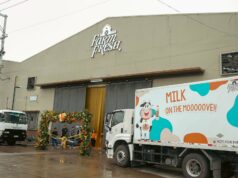ANGELES CITY – Hundreds of farming families in four barangays in Sta. Cruz, Zambales now live hand-to-mouth existence, but are left with no choice but to rely on commercial bottled mineral water for their daily needs.
Affected folk have blamed unbridled mining operations that have reportedly also totally wiped out forests on the mountains of their town where, of the hundreds of folk engaged in farming for generations, only one person holds a certificate of land transfer (CLT) under the government’s agrarian reform program.
This was among the findings of the Movement for the Protection of the Environment (Move Now), a non-government organization which has concluded a fact-finding mission on the adverse effects of massive nickel mining in the villages of Guisguis, Gumabon, Lomboy and Canaynayan in Sta. Cruz.
Move Now said much of Northern Zambales are covered by mining for chromite and nickel, the central part for magnetite and southern part for copper and gold.
“The forests in the Sta. Cruz mountains are now totally wiped out, the local river is dead and useless to local folk, the water from pumps cause skin diseases and is not potable, and their rice lands are no longer as productive,” said the report of Move Now whose members spent several days in the affected areas last week.
The report said that because water from local waterways and their deep well pumps have become contaminated, residents in the four barangays are compelled to buy bottled water for their daily consumption.
Reporting from Zambales, Joseph Canlas, a member of the fact finding mission and chairperson of the Alyansa ng Magbubukid ng Gitnang Luson (AMGL), noted that “the atmosphere here is intolerable as trucks that carry ore from the mining site are everywhere, they operate full 24 hours a day.
It is unbelievable that officials of local government units could allow this.”
Move Now also documented damages to properties resulting from worsening flashfloods and landslides in Guisguis and Lomboy during the rainy season.
It noted that over the years waters from the mining areas upland have turned to reddish the color of a wide swath of local farmlands, reducing rice harvests to only 50 to 70 cavans per hectare, below the 100 cavans they used to harvest before the massive mining operations came.
“Farmers could no longer source the mountain and river for wood, food, cogon and other necessities,” Canlas noted.
Move Now also noted that folk in the four barangays “perennially suffer from cough and colds, eye irritation and itchiness on their skin” amid dust from trucks and nickel mining operations in the nearby mountains.
“We also found out that farmers are usually tenants and farmworkers cultivating one to two hectares and paying their landlords 12 cavans per cropping,” Canlas noted.
Canlas cited that case of a tenant from Lomboy who has been farming a one hectare land for four decades and yet has never heard of the government’s land reform program.
“In the four barangays in Sta. Cruz, we documented only one farmer, also from Lomboy, who had a Certificate of Land Transfer (CLT),” Canlas added.
Citing data from the Mines and GeoSciences Bureau, Move Now named the mining firms operating in Sta. Cruz as Benguetcorp covering 1,406 hectares, Eramen with 4,619 hectares extending to Candelaria town, Shangfil with 449 hectares, Filipinas with 951 hectares.
“Almost all of the northern towns of Zambales are covered by mining operations and their owners have set-up their private ports as conduit to ship out the mineral resources of the province, such as those in Barangay Bolitoc, Sta. Cruz,” the report said.




